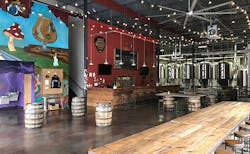Case Study: Two-stage Kettle Cleaning has Brewery Whistling While They Work
Cleaning beerstone and wort residue is pretty much the same song, different verse for many craft brewers, but Mike McCarthy and the team at Ocelot Brewing are humming a different tune. The two-year old taproom in Sterling, Virginia brewed 1,500 barrels of beer in 2016, but you’d never know it looking at their brewing kettles—they look brand new.
Rather than hand scrubbing their kettles, Ocelot Brewing uses a unique two-step cleaning process that relies on diluted alkaline chemicals and a resulting thermodynamic reaction that dissolves stubborn wort and beerstone residue. By letting the process do the cleaning for him, McCarthy and his team are free to do other brewing tasks— or kick back and do some quality control taste testing.
They like big beers and they cannot lie…
Ocelot Brewing began out of a combined passion for beer and music, and to this day, all of their beers are named after song titles. The company itself is named after a Phish song, and the tap list on any given day will tingle your tastebuds and your ears. With a focus on IPAs, Ocelot brews the gamut: barrel-aged beers, pilsners, saisons and Vienna lagers, to name a few.
A production brewery with a taproom, Ocelot operates out of a 15-barrel brew house with six 30-barrel fermenters. While the taproom accounts for about 70% of their business, Ocelot distributes locally across northern Virginia and the Washington D.C. area.
Although Ocelot Brewing is only in its second year, McCarthy is a veteran brewer and worked for a number of years at another local brewery, DC Brau, where he learned the two-stage cleaning process.
The (kettle cleaning) Stairway to Heaven
While its outcome is undoubtedly delicious, the brewing process is messy, requiring multiple long rounds of boiling— first the grain, then the wort and hops. After all the good stuff is pumped out, the kettle is stained with deposits of beer stone, wort extract, hop lipids and more. Whether steam jackets or open flame, the build-up is most prevalent around the heat source.
The deposits have to be thoroughly removed so that buildup doesn’t fall into the kettle or impede the heating and temperature buildup in the kettle. Most brewers turn to caustic chemicals and peroxide additives, and still have to manually scrub the kettle walls—a time consuming and labor intensive chore, until one Master Brewer found a better way.
Steve Gerloff, a Master Brewer and Technical Sales Rep for Madison Chemical, devised a two-step approach to dissolve brewing buildup. First, a specially inhibited acid formulation called Compound LD5 is introduced into the tank. Used at a dilution of 1-2% depending upon soil loading and cleaning frequency, the LD5 dissolves the crystalline structure of the scale by dissolving the carbonate bond within the scale deposit via a thermodynamic reaction. This acid cycle runs 15-45 minutes at 155 F, and the brewer can “set it and forget it” while the LD5 does the scouring.
Once the LD5 is drained and the kettle has been rinsed, the second cycle begins. For this step, the brewer uses a 1-2% diluted solution of Enviro-Clean BOIL OUT, a specialty formulated alkaline designed specifically for hot-side brewery cleaning. This two-stage cleaning process completely removes the scale deposit without any additional scrubbing or scraping required.
For safety, McCarthy and his team use eye protection as well as gloves. They rinse the tank and all connected piping thoroughly between cycles.
An additional step that McCarthy learned from DC Brau was the addition of a sanitary streamline strainer to trap any sheeted soil load that is removed in the process, which prevents spray balls from clogging the kettle drain.
All You Need is Love (and beer)
McCarthy still has nightmares about cleaning kettles in the good ol’ days, before he learned about the LD5/BOIL OUT combination. Despite scrubbing with brushes or using caustic chemicals like Professional Brewers Wash, malt stains proved stubborn. Not anymore: The two-step process delivers a double whammy. First the LD5 treats the malt stains and breaks down the crystallization on the stainless steel. Then the BOIL OUT delivers a knock out punch, rinsing away any leftover stains.
When it came time to decide how Ocelot was going to clean the kettles, McCarthy had an easy decision. Coming from the larger DC Brau, which runs 15-20,000 barrels a year, with kettles running around the clock, McCarthy knew the process would work on a smaller scale.
“We’re much smaller, so the kettles aren’t even as dirty—the process works like a charm,” he said.
McCarthy noted that switching to the two-step process wasn’t a time-saving measure, but rather a labor-saving one. Running two 30-minute cycles isn’t any faster than running a 30-minute cycle and then scrubbing the kettle for 30 minutes. By making the BOIL OUT do the heavy lifting in that second cycle, McCarthy and his team can be doing something more productive like attending to other cleaning cycles.
“We don’t run six days a week like other larger breweries, but still, we appreciate the labor savings. We’re certainly more productive by doings something else while the process is running unattended,” he said.
Even in a smaller craft brewing environment like McCarthy’s operation at Ocelot Brewing, deposit occurs during the brewing process and the kettles must be cleaned. By using the two-stage process, McCarthy and his team let the chemicals do all the scouring, saving valuable manpower for more important things, like taste testing, or brainstorming music-related titles for their next batch.
